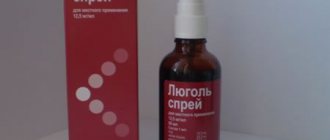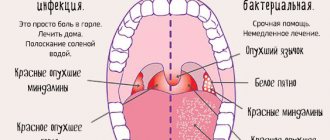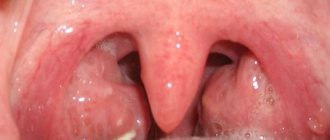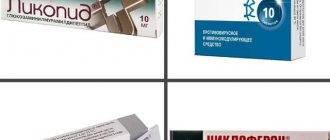Author of the article
Volyk Larisa Vladimirovna
Reading time: 6 minutes
AA
Today you can often hear a patient complain about a red throat, but not all patients fully understand what is meant by this symptom. Basically, when complaining to the doctor, the patient means changes in the color of a small area of the mucous membrane, which can be seen without special equipment.
It is important to understand, especially when it comes to a small child, that redness of the mucous membrane in isolation does not mean anything and is not even a sign of any disease. The doctor must evaluate additional symptoms in order to draw conclusions about the presence or absence of any pathology in the patient.
Causes of redness
If a person, be it an adult or a child, is completely healthy, the mucous membrane of his throat will have a uniform pink color. The tone can be individual, since the main criterion is the uniformity of color, the absence of areas of redness or the appearance of mucous plaque.
It is important to understand that there are only two mechanisms that can lead to a change in the color of the mucous membrane. In the first case, we are talking about a strong expansion of blood vessels, which is called hyperemia. Hyperemia mainly develops due to the effect on the mucous membrane of various irritating factors, which are the same for children and adults. These include:
- irritation of the mucous membranes by various pathogenic microorganisms can lead to reflex vasodilation (it is worth keeping in mind that we are talking not only about bacteria, but also about viruses and fungi);
- contact with various chemicals (for example, tobacco smoke, some allergens that have an aerosol distribution mechanism, such as dust or pollen);
- exposure to factors of a physical nature (mainly a prolonged scream, the need to speak for a long time in a raised voice, the need to conduct a conversation in a room with dry air);
- exposure to mechanical factors, which can also irritate the mucous membrane of the throat (consumption of various lollipops and other solid foods);
- exposure to thermally aggressive environments (consumption of excessively hot or too cold drinks or foods).
The second mechanism that ensures staining of mucous membranes is their contact with food-type dyes. It can also cause redness in both adults and small children. Moreover, if with adults everything is more or less clear, then in the case of a child, parents may well forget that the baby ate some kind of sweetness.
Causes
Red arches in a child’s throat are difficult to cure unless the etiology of the pathological process is determined. To do this, you will need to perform a pharyngoscopy and examine the sputum in the laboratory. Based on the visible symptoms, the attending physician can only assume the predominant disease, but is not able to make a definitive diagnosis. Pathogenic factors that provoke redness in the throat can be physiological and pathological. In the first case, the reasons are:
- presence of a foreign body in the throat;
- allergic reaction to a food product;
- a consequence of hypothermia.
- The pathological causes of a red throat are as follows:
- cold;
- ARVI, influenza;
- viral infection;
- streptococci;
- other diseases of the body not related to the respiratory system.
Constantly red throat in an adult
A sore throat requires warmth, but such therapeutic measures provide only temporary relief, then they bother you again with greater force. You need to find out the main reason why an adult has constantly reddened oral mucosa, and then eliminate it from your daily routine. Here are the potential pathogenic factors for this condition:
- pathologies of the gastrointestinal tract, for example, reflux esophagitis;
- eating spicy or very hot food with subsequent irritation of the mucous membranes;
- irritation of the pharynx with chemical vapors, dust;
- chronic tonsillitis pharyngitis;
- allergic reaction;
- the presence of bad habits.
- Dietary zucchini pancakes in the oven and slow cooker. Recipes for zucchini pancakes with photos
- Fibrocystic mastopathy of the breast: treatment
- Herb for cats against vitamin deficiency. How to plant your cats' favorite grass at home
No temperature
The throat may be red, but not painful. In this case, we are talking about an allergic reaction or local irritation in response to external factors. Hyperemia of the mucous membrane accompanies internal discomfort and provokes the sensation of a foreign body in the oropharynx. To combat obvious irritation, the throat of an adult patient or child is thoroughly lubricated with local antiseptics, but the allergen, the main irritant, is first removed. Additionally, it is recommended to examine the body’s digestive system.
Why is my throat red but not painful?
If there is visible redness in the throat, but there is no pain, this does not mean that there is no health problem. It is possible that the larynx will begin to hurt later if conservative treatment is not started in a timely manner. Potential causes of inflammation of the tonsils may be:
- mucosal injury;
- a consequence of the interaction of the mucous membrane with toxins;
- thermal damage to the mucous membrane of the pharynx;
- harmful effects of the allergen;
- presence of bad habits (in adulthood).
The child has
Hyperemia of the throat in childhood is often characteristic of purulent sore throat, and redness of the throat is accompanied by acute pain, white plaque, cough and severe runny nose. The disease begins with a sore throat, which, with chronic inflammation, can become an unpleasant part of everyday life. Other equally dangerous reasons why a child has a red sky are:
- colds, ARVI;
- influenza, parainfluenza;
- stomatitis;
- tonsillitis;
- scarlet fever;
- laryngitis;
- pharyngitis.
Why is my throat always red?
Sometimes an adult sees in the mirror (or during examination) that the throat, or rather the mucous membrane of himself or his child, has an unhealthy red color on a constant basis. In this case, many immediately think about some negative pathological process occurring in the body in a hidden form.
It is important to understand that if the mucous membrane does not return to its normal color for a long time, it is recommended to visit an ENT doctor so that he can examine the patient and suggest what could be causing such changes.
Today there are not many chronic infections that can cause redness of the throat on a permanent basis. First of all, speaking about infectious diseases, it is worth remembering tonsillitis and pharyngitis. It will be enough for a specialist to simply examine the patient’s throat to make one of these diagnoses.
If we are talking about tonsillitis, the doctor will definitely pay attention to the condition of the patient’s tonsils. An increase in their size and a loose structure, uncharacteristic of this organ, will attract his attention. With good lighting and careful examination, you can even see the sulfur plugs filling the lacunae.
With pharyngitis, it is important to keep in mind that the tonsils will not be involved in the pathological process. With this pathology, the doctor’s main attention will be drawn to the back of the pharynx, the color of which may change slightly. The main diagnostic criterion will be the detection of small tubercles on the surface of the mucosa, which are enlarged lymphatic follicles. In these follicular formations there is an active fight against pathogenic infections that have entered the body.
If an adult has a red throat, what are the reasons?
When your throat is inflamed, it needs warmth. Of course, this is only a temporary measure to alleviate the general condition.
To get rid of the symptom completely, treatment is necessary. And for this you need to consult a doctor and start searching for the cause of the disease.
It is very important to understand why an adult suffers from constant redness of the throat mucosa. And once the cause is established, get rid of this problem.
Typically, hyperemia of the mucous tissues of the throat is caused by the following factors and conditions:
✔ Diseases of the gastrointestinal tract (for example, reflux esophagitis, and others).
✔ Allergic reaction to food.
✔ Ingestion of food containing sharp, irritating and hot components that cause inflammation of the mucous membrane.
✔ Contact with chemicals, inhalation of dust, hazardous vapors.
✔ Chronic pharyngitis and tonsillitis.
✔ Consequences of bad habits.
What are the causes of redness of the throat without fever?
Very often, only redness of the throat is observed, which is not accompanied by other symptoms.
Most often, the cause lies in an allergic reaction. Often a symptom occurs as a result of a physiological reaction to some external factors.
Due to the redness of the throat, some discomfort appears, in particular, the patient feels as if there is some kind of foreign object in his throat.
Therefore, it is necessary to eliminate irritation and alleviate the condition, even if it is caused by physiological reactions.
To do this, exclude exposure to an allergen or other irritant, and the throat is treated with appropriate antiseptics. In addition, it is recommended to check the patient’s gastrointestinal tract to exclude the influence of internal diseases on the condition of the throat.
Causes of painless redness of the throat
Many people think that if their red throat does not hurt, there are no problems. This is not true at all. Pain and other symptoms may appear later.
But if you start treatment right away, negative symptoms can quickly go away, and the body can improve its functioning. Tonsils may become red and inflamed for the following reasons:
- Thermal effects of hot food or drinks.
- Injured mucous membrane.
- Harmful effects of toxic chemicals.
- Allergens entering the mucous membrane.
- The influence of bad habits.
Additional symptoms
In most cases, pathological staining of the mucous membrane in the throat area, both in adults and in children, does not occur in isolation. Many people unwittingly pay attention to additional signs, which force them to see a doctor in the first place. These include:
- the appearance of a constant unpleasant cough;
- the appearance of a feeling of pain in the throat;
- loss of appetite, which in children can be explained by a pronounced feeling of discomfort when trying to swallow;
- increase in body temperature, etc.
When contacting a doctor, it is necessary to draw his attention not only to a red throat, but also to additional symptoms indicating the presence of some pathological process in the body. A detailed story about the symptoms will allow the doctor to most reliably establish the diagnosis and select the most appropriate treatment.
If the mucous surface of the throat is red for a long period of time, but there are no additional symptoms indicating any disease, then consultation with a specialist is still necessary. Hyperemia of the mucous membrane cannot just happen, which means it is necessary to figure out what pathological process led to the redness and how dangerous it is for the patient.
It is also important to remember that the throat is an element of the body that is involved not only in the process of breathing, but also in the process of digestion. This suggests that the problems may be associated with various diseases of the gastrointestinal tract. Most often, chronic gastritis, which is in the acute stage, leads to redness of the throat, but the reasons may lie in other pathologies.
If it seems that there are no obvious reasons for the appearance of redness, it is recommended to soberly assess the situation. Sometimes, to eliminate unpleasant redness, a person simply needs to humidify the air in the room in which he is located, or give up the addiction to smoking.
- Causes of blood from the throat when coughing;
- What cough syrups to take while carrying a baby;
- How to treat a sore throat at home.
Antibiotics for the treatment of red throat
Ospamox
Ospamox drug in tablet form
A broad-spectrum drug that is suitable for use for sore throats. Adults can take from 750 to 3 g of active substance. Patients with large body weight usually receive a higher dosage. The prescribed amount of the drug must be divided into three doses, and it is advisable to drink it after meals in order to reduce the negative effect on the gastrointestinal tract. The maximum course of use of Ospamox is 10 days, but it is also worth taking into account the patient’s medical history and his reaction to the therapy.
Amoxicillin
Amoxicillin capsules
It is also advisable to use the medication after meals, washing it down with a small amount of clean water, to reduce intoxication of the entire body. For adult patients, taking into account the functioning of the kidneys and liver, as well as the current condition, they can be prescribed from 250 to 500 mg two to three times a day. It is usually recommended to take 500 mg in the morning and evening. The duration of therapy is determined individually, but it cannot be less than five or more than ten days. When using Amoxicillin, you should take medications with stomach-friendly bacteria and probiotics.
Augmentin
Augmentin for adults
A milder antibiotic, which is produced in the form of tablets and suspensions. Adults are usually prescribed the tablet form of Augmentin. Depending on the patient’s condition and the presence of complications with the throat, a dosage of 250 to 875 mg of the active substance can be prescribed. People with greater body weight will be prescribed a larger dosage. In the first days of therapy, the specialist may also recommend taking the maximum or average dose, and then reducing it to the minimum. The duration of treatment is usually between five and ten days, but depends on many factors that the therapist must consider.
Attention! Antibiotics are usually prescribed in situations where previous treatment has not produced any results and complications have arisen.
How to treat a red throat without medications
A red throat can indicate a wide range of different medical conditions. It is imperative to establish the specific cause of the pathology before starting any treatment for a sore throat. Establishing the cause will not only help prevent possible complications due to the rapid development of the disease, but will also prevent the body from reacting negatively to incorrectly selected therapy. If the cause of pathological changes in the mucosa has not been established, it is recommended not to use any medications, even if they seem safe.
Today, it is popular to treat various diseases without medications. It is necessary to understand that such therapy will be effective only in the first stages of the disease. If the disease has already developed, then you will have to abandon simple methods of traditional medicine. But simple methods will help to significantly alleviate the patient’s condition if you contact a specialist immediately.
You can protect your throat by first giving up drinking alcohol and smoking, at least for the duration of your illness. Even a temporary renunciation of these addictions will protect the mucous membrane of the throat, easing the patient’s condition. It is also necessary for some time not to eat dishes with excessive spice, which can also have an irritating effect on the mucous membranes.
As a preliminary way to alleviate your condition, you can also use, for example, soda inhalations or inhalations over a variety of essential oils. Gargling with decoctions of herbs that have an anti-inflammatory effect is also suitable. So you can use chamomile decoction, warm water with salt, gargling with sage.
Treatment using non-drug means is suitable not only when it is not possible to quickly see a doctor, but also when we are talking about a representative of the fair sex who is carrying a child. After all, pregnant women are also prohibited from using many medications.
How to treat
If a red arch is present in the throat, many patients begin conservative treatment with antibiotics. In fact, this method works if a progressive disease is provoked by increased activity of bacterial flora - streptococci, staphylococci, enterococci. In other clinical situations, it is advisable to use antiseptics externally, and for viral infections, systemic antimicrobials.
Other medical interventions are presented below:
- In the fight against swelling, it is better to use chamomile infusion or soda composition for daily rinsing.
- If the mucous membrane of the throat has small spots, and the patient has difficulty breathing, it’s time to suspect scarlet fever and promptly contact your local pediatrician (general practitioner).
- Gargling with a decoction of calendula, for example, softens the throat, but is not able to destroy pathogenic flora (if any).
Medications
The red mucous membrane of the throat is successfully treated with conservative methods and physiotherapeutic procedures. These are antiseptic sprays and bactericidal solutions, oral tablets, and lozenges dissolved under the tongue. Their therapeutic effect is local; penetration of active components into the systemic bloodstream is not observed. In such a clinical picture, it is appropriate to use several pharmacological groups at once, including:
- local antiseptics in the form of lozenges for resorption: Isla, Strepsils;
- disinfectants: Givalex, Rotokan, Trachisan;
- immunostimulants: Amiksin, Remantadine;
- local antibiotics: Bioparox, Stopangin;
- systemic antibiotics: Amoxiclav, Zinnat.
- What can be made from clay
- Curtain design for the hall
- How to find out the owner's phone number
If we talk about the most effective medications for the conservative treatment of red larynx, it is recommended to highlight the following pharmacological positions:
- Amiksin . These are pills that can enhance the body's immune response. It is recommended to take 1 pill orally twice a day - morning and evening for the purpose of treatment, 1 pill - daily for effective prevention.
- Strepsils . These are effective and affordable oral tablets. It is recommended to take 3 – 5 pills per day until the alarming symptoms – redness, pain and soreness – completely disappear.
Antibacterial
If the red larynx is bacterial in nature, it is imperative to take antibiotics internally and externally. This is a reliable way to reduce the viability of pathogenic flora, completely destroy harmful microbes, and speed up the natural healing process. Doctors recommend the following medications:
- Bioparox . Spray for spraying a medicinal composition into a sore throat. The medication will be used externally, effectively treating the red mucous membranes. The course of intensive therapy is 5 – 7 days.
- Amoxiclav . These are systemic antibiotics for oral administration. Take 1 capsule three times a day for 7 – 10 days. Take a single dose with plenty of water, swallow and do not chew.
Spray irrigation
With a red larynx, the first thing the patient undergoes is an examination to accurately determine and further eliminate the main pathogenic factor. They destroy pathogenic flora using medicinal methods, and with the help of antiseptic sprays and solutions, you can productively remove the visible symptoms of a sore throat and speed up the recovery of injured tissues. Here are effective treatments:
- Lugol . A solution with a specific taste, which needs to be generously lubricated on the red mucous membrane in the morning and evening for 10 to 14 days.
- Chlorophyllipt . This is a spray that is also supposed to efficiently treat the red larynx up to 3 times a day. It is advisable to continue treatment until complete recovery.
Vitamins and restoratives
To strengthen the immune system, adults and children need to consume vitamin C, get it from natural foods or multivitamin complexes for all age categories. This is especially important during the period of seasonal vitamin deficiency. The following pharmacological positions have proven themselves well:
- multivitamin complexes : Duovit, AlfaVit, Pikovit;
- immunostimulants : Interferon, Cycloferon, Polyoxidonium.
How to rinse
Homemade warm compresses on the throat are excellent, but in order to enhance the overall therapeutic effect, it is advisable to use medications in combination to regularly rinse the red larynx. In the latter case, we are talking about the following proven medications:
- Iodinol . It is required to add 15 ml of the specified medication to 250 ml of water and mix. Gargle three times a day, while holding the sip of liquid on the mucous membrane for no more than 15 seconds.
- Furacilin . It is required to dissolve 2 g of the drug granules in 300 ml of warm water and mix thoroughly. Use the prepared composition for gargling up to 5 times a day for 5 – 7 days.
Inhalations
Delay leads to chronic pharyngitis, tonsillitis, and laryngitis. To prevent this from happening, a red throat needs to be treated with home inhalations. For example, steam treatments with eucalyptus or sage essential oil are especially useful. You can also use a potato or soda mixture with the addition of a few drops of iodine in the latter case. The benefits of steam procedures are obvious:
- elimination of the inflammatory process;
- removal of mucus and accumulated purulent plaque;
- relief from irritation and visible redness;
- easier breathing;
- accelerated healing process.
Komarovsky's advice for redness of the throat
The most common cause of redness of the throat is contact of the mucous membrane with a variety of viruses and bacteria. In this case, the most reliable means of therapy for both children and adults will be medications. The most commonly prescribed medications today are Iodinol or Furacilin.
Also in prescriptions you can find Lugol's solution, intended for lubricating diseased areas.
If the inflammatory reaction was caught in the early stages, then various lozenges or tablets can be used for therapy. Faringosept or Septolete will do. Both of these medications relieve pain through an analgesic effect and also help prevent further progression of the disease.
The famous pediatrician Komarovsky also gives parents several recommendations that must be followed if the child becomes ill. These include:
- when a temperature appears against the background of a sore throat, it is recommended to adhere to bed rest so that complications affecting the heart do not subsequently develop;
- the patient is forbidden to offer hard food, which can somehow injure the mucous membrane of the throat even more; he is recommended soft food that will not be painful to swallow (broths, purees);
- the effectiveness of treatment can be increased by observing the drinking regime and increasing the amount of liquid consumed in various types (the most useful will be a variety of juices, fruit drinks, herbal teas, which can alleviate the patient’s condition not only by accelerating the elimination of toxins, but also due to the large number of useful substances in the composition );
- when treating a child, you cannot refuse a course of antibiotics if they are prescribed by a doctor and, moreover, you must take the full prescribed course to avoid complications of the disease;
- rinsing, according to Dr. Komarovsky, will be especially useful, especially if done often enough (up to 6 times a day).
It is important to understand that you should not attempt to treat red throat on your own in any case. It is better to consult your doctor once again and make sure that the disease does not pose a danger.
How to treat red throat in children
Causes of red throat
Contents [Show]
Redness in the throat causes concern, as everyone is accustomed to considering this the first sign of a cold. In most cases, this is true, since the mucous membrane is the most vulnerable place of the body; This is how it responds to contact with bacteria and viruses.
The most common cause of a red throat in adults is the inflammatory process of ARVI. In this case, you should consult a doctor; strictly follow the recommendations; treat the problem. You can use proven grandmother’s methods (rinse or irrigate with herbal decoctions, drink warm milk with honey, make a delicious medicine from the same honey and aloe juice; hot foot baths). The main thing is not to let the problem take its course, otherwise you risk that the infection will go further along the respiratory tract and develop into a complication - sore throat, bronchitis, pneumonia.
Cold air can cause your throat to become red.
But other factors not related to viral infection may also be the cause:
- overeating cold foods, such as ice cream; excessively hot, spicy food gives the same effect;
- swallowing cold air in winter;
- allergic reaction to external irritants (dust, wool, smoky room);
- long conversation in a raised voice;
- low air humidity and dry microclimate cause soreness and cough;
- love of hard foods that can scratch.
Such reasons do not require special drug treatment; you need to reconsider your habits and body characteristics.
Adults and children have a constantly red throat. The next block of reasons is more serious and is associated with chronic throat diseases; nasopharynx; oral cavity, they must be treated:
- Chronic tonsillitis is a severe inflammation of the tonsils (they become red), usually begins with a sore throat, and is its acute manifestation. Unpleasant white “plugs” appear - ulcers.
- Chronic pharyngitis is inflammation of the back wall of the pharynx. The sick person feels his throat sore, something is preventing him from swallowing, and at the same time the pain, cough, and temperature rise increase. It is the wall of the pharynx, not the tonsils, that is red.
- Sinusitis, sinusitis, deviated nasal septum - problems with the nose also cause redness, since the mucous membranes are located close to one another (often the inflammatory process affects the entire nasopharynx).
- Diseases of the stomach and gallbladder can affect the condition of the throat. Mucus from the stomach passes up and leads to the spread of infection in the throat.
- Dental disease, especially caries, is a constant source of harmful microorganisms in the mouth. In this case, a red throat is a common symptom.
Prevention of chronic diseases: rinsing, inhalation, physiotherapy.
Chronic diseases should be monitored and preventive treatment carried out (rinses, inhalations, physiotherapy). Ailments of different origins, in addition to redness of the throat, add other symptoms of varying degrees of manifestation.
Redness of the throat, heaviness when inhaling, abdominal pain, and fever require calling a doctor. If redness is a single symptom, carry out a set of home treatments using available remedies. A constantly red throat in adults may not hurt, so you need to be careful.
In babies, redness occurs when the first teeth appear, because this is a painful process that is even accompanied by fever. This problem in infants without fever occurs as a result of constant crying and external allergic irritants. If you have a fever, you need to start treatment immediately (but without antibiotics!). It is worth trying to treat with traditional methods, adjusting the drinking regime (additive to mother's milk).
A smear of the tonsils will help to correctly diagnose the disease and find the source of inflammation. A red throat causes discomfort and may be accompanied by:
- body temperature exceeding normal;
- pain reaction;
- poor appetite due to discomfort when swallowing;
- headache.
A red throat can be due to mechanical reasons that arise from external irritants and the development of viral infections in the human body - internal provocateurs. Such diseases can be isolated or chronic, but both cases need to be treated. You should not joke with a red throat, so as not to earn additional diseases.
Inflammation in the throat brings with it many unpleasant symptoms, poor health, weakness, and inability to eat normally. A sick person wants to get rid of the disease as quickly as possible, so he tries to use various medications, often resorting to antibiotics as a universal remedy.
However, these drugs are not always effective and in some cases can even cause harm. Treatment of any disease accompanied by inflammation and redness of the throat must take into account the type of infection that led to the disease.
“Red throat” can be a symptom of a number of diseases
Redness of the throat is not an independent disease, but just a common symptom that can accompany many diseases. The cause of redness is infection, and it can be viral, fungal and bacterial:
- Most often, redness of the throat is a consequence of a bacterial infection. This symptom is accompanied by tonsillitis, or tonsillitis, laryngitis, pharyngitis and many other diseases. Scarlet fever is very dangerous - a disease that has now become rare, which threatens serious complications, especially cardiac activity. A characteristic sign of scarlet fever is a crimson tongue, a red throat and a specific rash on the body.
- A red throat is a common complication after the flu, if the disease was latent, “on the feet.” Both the underlying disease caused by the virus and its consequences will have to be treated.
- Much less commonly, redness is caused by a fungal infection. In order to choose the right medications, it is necessary to know the true nature of the original disease. This is due to the fact that some drugs are very effective against one type of pathogen, but are absolutely useless and even harmful when used against others.
In some cases, the redness of the throat is not caused by illness, but by physical, mechanical reasons. Basically, this is overexertion, provoked by heavy loads - prolonged speaking, especially in a raised voice, singing, screaming, crying. In this case, not only the vocal cords react painfully, but also the mucous membranes, which dry out, hurt and become inflamed, and the throat turns red.
In this state, it is very easy to “pick up” any infection, which may even lie dormant in the person’s body, so it is imperative to treat the irritation. In this case, special lollipops work well, they have a softening, analgesic and antiseptic effect.
Useful video - How to treat a red throat at home:
Throat irritation with redness can also appear for other reasons. It can be triggered by an acute allergic reaction, which must be treated with specific antiallergic drugs. Also, the cause of redness in the throat can be chemicals, for example, inhalation of vapors of various dyes, chlorine, solvents, glue and other caustic compounds. In mild forms of poisoning, you can simply drink milk, which binds well and removes toxins. But serious poisoning will require urgent hospitalization.
Other irritants can also cause severe redness, for example, inhaling polluted or dusty air, salt water when swimming in the sea, or a reaction to too spicy and hot food. Such conditions are usually temporary, do not require treatment and go away on their own relatively quickly.
A red throat is only a symptom; to prescribe medication, the doctor must identify the cause
Many believe that the best way to demonstrate how to quickly cure a red throat is to take antibiotics. However, this is not always the case. Antibiotics are effective only against bacterial infections, and even then they need to be selected individually, taking into account the group of pathogens that led to the appearance of redness in the throat.
In addition, these drugs have a large number of contraindications, so they can be used exclusively for health reasons as prescribed by a doctor. It is impossible to exceed the dosage, lengthen or shorten the duration of taking antibiotics, because this can lead to the fact that the disease either remains untreated, or the drugs cause harm to the body, suppressing the vital activity of beneficial microorganisms - the intestinal microflora. This will lead to the development of an unpleasant and dangerous condition for health - dysbiosis, so treatment with antibiotics does not in all cases bring only benefits.
To treat a red throat, antibiotics are a last resort. Basically, the doctor prescribes anti-inflammatory, painkillers and antipyretics, as well as antihistamines.
For inflammation of the throat, local procedures are excellent: gargles, compresses, lubricating the throat with various solutions, and the use of medicinal aerosols.
It must be remembered that compresses and any other heat can be used only if there is no purulent process in the throat. Otherwise, the heat will dilate the blood vessels and increase blood circulation, as a result of which the infection can be spread by the bloodstream throughout the body.
For purulent formations, an old and proven remedy - Lugol's solution - works well. They carefully and carefully lubricate the patient’s throat. Usually inflammation, even very severe, goes away fairly quickly.
Gargling is a mandatory procedure for throat diseases.
Traditional medicine knows how to quickly cure a red throat with simple home methods:
- First of all, the patient is advised to drink as much as possible to remove toxins from the body. To do this, you should use warm and vitamin drinks. Warm milk with the addition of butter and natural honey works great. This mixture quickly softens the throat, reduces pain and makes swallowing easier. If the redness of the throat is accompanied by severe irritation and cough, you should add a piece of goat fat to the milk.
- Equally effective is tea with honey and lemon, with raspberries and other berries rich in vitamins.
- When the throat is red, accompanied by a rise in temperature, the patient is given a linden decoction, to which it is also good to add a spoonful of honey, ideally linden or acacia (if the patient is not allergic to bee products).
- Drinking a decoction of rose hips works well. It contains a lot of vitamin C, which is very effective against colds.
- Another great simple remedy is gargling. For it to be truly effective, you need to gargle as often as possible, in the early stages - every hour. The best rinse composition is a solution of sea salt and baking soda with warm water. If the inflammation is severe, there are signs of a sore throat, or purulent plugs form in the throat, it is worth adding a few drops of iodine tincture to the solution.
- You can also gargle with herbal decoctions, such as chamomile, mint, eucalyptus and sage. They act anti-inflammatory, relieve swelling, reduce dryness and irritation, and destroy harmful microflora.
- In case of severe dryness and soreness of the pharynx, it is worth using inhalations. At home, the easiest way is to “breathe potatoes.” To do this, boil a couple of tubers in their uniforms until tender, sprinkle with baking soda powder and quickly allow the patient to breathe hot steam, covering him with a large terry towel. Potatoes can be replaced with a strong soda solution. The steam quickly softens the throat and even relieves bronchospasm.
Treatment of red throat in pregnant women should be under the supervision of a doctor.
The main problem with treating a throat in an infant is the inability to use a number of medications, as well as other useful and effective methods, such as gargling. Therefore, the best way to relieve a baby from redness in the throat is inhalation with a nebulizer.
The safest and most harmless composition is ordinary mineral water, soda is alkaline in nature. Borjomi is considered the standard of such mineral water in our country. It can be used for inhalation even in the youngest children. Also, saline solution is used for them, and special preparations for babies are diluted with it. For older children, the doctor may prescribe special medications in nebulas, ready for use in a nebulizer.
The problem of how to quickly cure a sore throat in a pregnant woman is similar to what parents of a sick baby face.
It is highly undesirable for a pregnant woman to use medications except in very severe cases. The best way for a woman expecting a baby is to use local treatments - rinsing, washing, irrigating and lubricating, drinking vitamin drinks and other simple home remedies that are harmless to the fetus.
Redness of the throat is a symptom that may indicate the onset of a dangerous disease, so you should definitely consult a doctor, especially if your health worsens sharply or rapidly.
A red throat is a symptom of many diseases, both infectious and non-infectious. Before you start treating a sore throat, it is always important to find out the cause of this phenomenon.
Throat is a common expression; there is no such anatomical term. When we say “throat hurts” or “throat is red,” we mean the part of the pharynx visible to the eye, or rather the oropharynx and pharynx - the opening connecting the oral cavity to the oropharynx. What exactly do we see when we look into a child’s mouth or examine our throat in the mirror? An arched hole is bounded on the sides by the palatine arches - anterior and posterior, between which the palatine tonsil is located; the soft palate (“uvula”) hangs above this hole, and we can also see the back wall of the pharynx.
The throat is the entrance gate for both food and inhaled air entering our body. That is why a person usually feels any inflammation of the throat immediately: the first symptom of inflammation of the throat is usually pain, especially noticeable when swallowing.
Redness, as you know, is a symptom of inflammation. When any pathogenic factor enters, a cellular immune reaction occurs, releasing inflammatory mediators that have a vasodilating effect. Due to the blood supply, we see redness and swelling (thickening) of the mucous membrane.
What diseases are accompanied by redness of the throat?
The most common causes of redness in the throat:
- Pharyngitis;
- Angina.
Pharyngitis is an inflammation of the walls of the pharynx. It can be either an independent disease or a symptom of other diseases. The cause of pharyngitis is an infection that reaches the mucous membrane, usually through airborne droplets. Predisposing factors for the development of inflammation are:
- Hypothermia of the body.
- Irritating food or drink (too hot or too cold, spicy, salty, sour, etc.)
- Ambient air pollution.
- Smoking, alcohol.
- Pathology of the nose and paranasal sinuses.
- Diseases of the esophagus and stomach.
- Trauma (burn).
- Allergic predisposition.
The main symptoms of pharyngitis are:
- A sore throat. The nature of the pain can be different - from severe (“like swallowing glass”) to barely noticeable. The severity of pain does not depend on the degree of redness of the throat, but rather on the level of the threshold of pain sensitivity. Pain can be felt both when swallowing food and during an “empty throat” (swallowing saliva), and in the latter case it occurs even more often.
- Discomfortable sensations in the throat: feeling of dryness, scratching, feeling of a lump or foreign body.
- Cough. A cough with pharyngitis begins with a sore or tickling sensation in the throat; the patient is constantly haunted by the desire to clear his throat in order to remove the “obstruction” in the throat. The cough is mostly dry, sometimes mucus is coughed up, but this does not bring relief.
Manifestations of pharyngitis
- Red wall of the throat: hyperemia of the palatine arches, soft palate, and pharyngeal walls. The tonsils are usually not affected. In children with viral pharyngitis, small red dots may be observed on the walls of the pharynx and palate.
- Granularity of the walls of the pharynx. Lymphoid tissue in the pharynx is located in follicles - small round formations scattered throughout the walls of the pharynx. During inflammation, it is the lymphoid tissue that takes the first blow of the infection. The follicles increase in size and become visible as small grains. Sometimes they can fester, then we are talking about purulent follicular pharyngitis.
- When bacterial flora is attached, a purulent or purulent-fibriosis plaque on the walls of the pharynx is possible.
A small child often cannot complain of a sore throat. Therefore, if symptoms such as anxiety, lethargy, refusal to eat, or fever appear, you need to look at the child’s throat.
Acute pharyngitis almost never occurs in isolation; most often it occurs as a symptom of acute respiratory infections in combination with rhinitis, tracheitis, and bronchitis.
In 80% of cases, pharyngitis is caused by viruses, so if you are diagnosed with this, you do not need to take antibiotics right away.
An increase in temperature and severe intoxication are also not typical for isolated pharyngitis.
Chronic pharyngitis occurs mainly against the background of concomitant diseases or constantly acting harmful factors. The redness does not go away even after the symptoms of exacerbation subside. A constantly red throat can be observed:
- For heavy smokers. The constant irritating effect of tobacco smoke takes its toll.
- In patients with gastroesophageal reflux. With this pathology, there is a reflux of gastric juice into the esophagus, and inflammation of the mucous membrane of the esophagus and pharynx occurs.
- For workers in hazardous industries.
- In persons with chronic sinusitis and rhinitis. Two factors are at play here: firstly, the constant flow of mucus from the nasal cavity along the wall of the pharynx, and secondly, impaired nasal breathing forces you to constantly breathe through the mouth.
- For allergic rhinopharyngitis.
If pharyngitis occurs against the background of acute respiratory infections or influenza, and is not accompanied by purulent deposits, conventional antiviral and local treatment is sufficient. Symptoms usually subside within 3-5 days.
Local effect for pharyngitis
The purpose of local treatment is to reduce pain, moisturize the mucous membrane, stimulate local immunity, and have an antiseptic effect.
The safest method of influencing the mucous membrane of the throat is exposure to saline solution. Saline solution can be bought at a pharmacy or prepared at home (for 1 glass of water - ½ teaspoon of sea or table salt). You can gargle with this solution in the usual way, you can irrigate it from a spray bottle or use a nebulizer. You can add a few drops of iodine to this solution.
Infusions of herbs - sage, chamomile, eucalyptus - are well suited for gargling.
Pharmacies sell many ready-made medications for local treatment of sore throats. You can choose the form of application that is convenient for you: rinse solution, aerosol or lozenges. They consist of one or more antiseptics, essential oils, local anesthetics, and less often they contain antibiotics and bacterial lysates. Main drugs:
- Rinse solutions – Miramistin, Octenisept, Rotocan, Povidone-iodine. You can also prepare the solution yourself from ready-made tinctures: propolis, calendula.
- Aerosols - Ingalipt, Cameton, Stopangin, Hexoral, Yox, Proposol.
- Lozenges - Sebidin, Anti-angin, Faringosept, Strepsils, Tantum Verde, Imudon.
All these drugs can be used independently for some time. Separately, it is necessary to mention medications containing antibiotics and sulfonamides - Bioparox, Grammidin, Stopangin 2A forte.
Preparations containing antibiotics (even if applied locally) should not be used for sore throat without a doctor’s prescription. Still, there are strict indications for prescribing antibiotics.
Why can't antibiotics be used without appropriate indications?
There are more or less constant numbers of several types of bacteria in the mouth and throat. This is normal microflora. Populations of opportunistic bacteria coexist peacefully with each other, occupy their niche and
do not allow “foreign” bacteria to spread.
Antibiotics kill not only pathogenic, but also this “peaceful” microflora. Moreover, the weakest species are killed first, while the strong and resistant to these same antibiotics continue to multiply. Let’s not forget that they are called “opportunistic”, that is, under certain conditions they can still cause diseases. And in the event that we really need an antibiotic, the previous drug will no longer help - we will need a stronger one.
But when is an antibiotic still needed? It is still up to the doctor to determine the indications for antibiotic therapy. But the main symptoms of bacterial rather than viral pharyngitis can be recalled. These are: purulent plaque on the walls of the pharynx, increased body temperature above 38 for more than 3 days, enlarged and painful submandibular lymph nodes, changes in blood tests (increased number of leukocytes, ESR).
And of course, there are diseases when antibiotics are simply necessary. In the first place is a sore throat.
Common cause of red throat: sore throat
Sore throat (acute tonsillitis) is an inflammatory process in the palatine tonsils (colloquially they are called tonsils). This disease is infectious, caused by pathogenic streptococci, less often by other bacteria.
The disease is manifested by severe sore throat and general intoxication of the body (high fever, headache, weakness, nausea). According to the clinical picture, tonsillitis is distinguished between catarrhal and purulent (follicular and lacunar), and there is also a purulent-necrotic form.
Symptoms of various forms of sore throat:
- In the catarrhal form , pronounced redness (hyperemia) of the palatine tonsils is determined; redness also extends to the palatine arches, soft palate, and the tonsils are enlarged in size. The tongue is dry and may be covered with a white coating.
- The follicular form is more severe. The follicles of the tonsils suppurate and are visible on their surface in the form of small ulcers.
- With lacunar angina, a continuous or islanded fibrinous-purulent plaque is observed on the tonsils. The plaque can be easily removed with a spatula.
- Purulent forms of sore throat are severe, the temperature can rise to 39-40, there is severe pain in the throat, and it is difficult to even open your mouth. The patient is worried about chills, lethargy, nausea, and lack of appetite. The submandibular lymph nodes also become inflamed - they enlarge and become painful. The illness can last from 6 to 8 days.
- Sore throat, unlike pharyngitis, is usually not accompanied by a cough or runny nose.
Sore throat is dangerous due to severe complications: suppuration of the surrounding peritonsillar tissue with the formation of an abscess, as well as long-term complications: the development of endocarditis, myocarditis, rheumatism, kidney disease.
Sore throat is exactly the disease that requires treatment with antibacterial drugs. Sore throat is contagious, so isolation of the patient is required, especially from children. In severe cases, hospitalization in an infectious diseases hospital is indicated.
In addition to all of the above measures that are used for pharyngitis, antibiotics are prescribed that have a detrimental effect on cocci bacteria. These are primarily drugs of the penicillin group - Phenoxymethylpenicillin, Amoxicillin, Augmentin, Amoxiclav. If this group is intolerant, cephalosporins (Cefotaxime, Cefuroxime) or macrolides (Azithromycin, Sumamed) are prescribed.
Systemic antibiotics can be combined with topical drugs. The duration of antibiotic therapy is up to 10 days.
If tonsillitis occurs several times a year, and the enlargement of the tonsils persists during the period between exacerbations, we will be talking about chronic tonsillitis.
Other diseases accompanied by redness of the throat
Redness of the throat may be the initial symptom of any infectious disease. If you see a red throat in a child and you know about an outbreak of any infection, careful monitoring is necessary. You need to remember the main infections in which the throat first turns red:
- Diphtheria. A fairly rare disease these days. It manifests itself as a picture of diphtheria sore throat, severe intoxication and severe complications.
- Scarlet fever. The disease begins with inflammation in the throat and a sharp rise in temperature. Upon examination, a very red throat is visible, and a bright red palate with a clear border of redness is also characteristic. Only after a few days does a pinpoint rash appear on the skin.
- Measles. With measles, the throat also turns red first and only after 3-4 days a rash appears on the skin. Measles has a typical symptom - Filatov-Koplik spots (light spots surrounded by a red rim), which appear at the beginning of the disease on the inner surface of the cheeks. Redness of the throat manifests itself in the form of spots of various shapes, merging with each other - measles enanthema. In the future, lacunar tonsillitis may develop.
- Infectious mononucleosis. It manifests itself as inflammation of the lymphoid structures in the throat (tonsillitis, follicular pharyngitis, adenoiditis), enlargement of the liver and spleen and generalized inflammation of the lymph nodes.
It must be remembered that redness with ulcerations in the throat may be the first sign of a blood disease (acute leukemia, agranulocytosis).
Red throat in infants and pregnant women - what to do?
Treatment of red throat in pregnant women should be under the supervision of a doctor.
The main problem with treating a throat in an infant is the inability to use a number of medications, as well as other useful and effective methods, such as gargling. Therefore, the best way to relieve a baby from redness in the throat is inhalation with a nebulizer.
The safest and most harmless composition is ordinary mineral water, soda is alkaline in nature. Borjomi is considered the standard of such mineral water in our country. It can be used for inhalation even in the youngest children. Also, saline solution is used for them, and special preparations for babies are diluted with it. For older children, the doctor may prescribe special medications in nebulas, ready for use in a nebulizer.
The problem of how to quickly cure a sore throat in a pregnant woman is similar to what parents of a sick baby face.
It is highly undesirable for a pregnant woman to use medications except in very severe cases. The best way for a woman expecting a baby is to use local treatments - rinsing, washing, irrigating and lubricating, drinking vitamin drinks and other simple home remedies that are harmless to the fetus.
Redness of the throat is a symptom that may indicate the onset of a dangerous disease, so you should definitely consult a doctor, especially if your health worsens sharply or rapidly.
Red throat in a child or an adult. How to treat the problem
If there is redness in the throat, most patients prefer not to go to the doctor, so they self-medicate.
The most popular group of drugs in this case are antibiotics. But this is a fundamentally wrong position, because, firstly, they are prescribed only in the presence of a bacterial pathogen (staphylococci, streptococci, enterococci, etc.), and secondly, resistance to them can develop.
It is best to practice the use of special external antiseptic drugs, combining them with the folk remedies listed below.
- To relieve swelling, make a decoction of chamomile herb, which is used to gargle every day. A solution of soda also works well.
- If there are many small spots on the mucous membrane of the throat, breathing becomes difficult, it is recommended not to look for folk and official remedies, but to consult a doctor, since signs of scarlet fever are clearly present.
- To alleviate pain and improve the condition of the throat, prepare a decoction of calendula for gargling. But this remedy will not kill foreign microorganisms, so treatment prescribed by a doctor should not be ruled out.
Medications
Redness of the throat is a condition that can be eliminated with simple pharmaceutical remedies, as well as with the help of physical therapy.
The main medications for a sore throat include antiseptic solutions and sprays, tablets for oral use, and special lozenges.
They act locally (with the exception of tablets) and are not carried through the bloodstream throughout the body, so the effect occurs faster and side effects are minimal. For a speedy recovery, it is better to use several drugs from the following groups at once:
✔ Absorbable lozenges with local antiseptics - Strepsils, Isla.
✔ Antiseptics - Givalex, Trachisan, Rotokan.
✔ Local antimicrobial drugs - Bioparox, Stopangin.
✔ Immunostimulants - Remantadine, Amiksin.
✔ Systemic antibiotic substances - Amoxiclav, Zinnat.
But of all the listed drugs, it is best to use the following remedies to eliminate redness of the throat.
- Amiksin. The drug was created to stimulate the body's immune system. When taken, the natural response to infection is enhanced. The principle of treatment is to take 1 tablet of the drug every morning and evening, and if you need to carry out prophylaxis, take 1 tablet every day.
- Strepsils. This drug is quite cheap and accessible, and its method of use is more than convenient. The product dissolves in the mouth like candy. Take 3-5 pills per day until not only the pain and soreness, but also the redness itself goes away.
Antibacterial drugs
In the case of a bacterial source of the red larynx, it is necessary to treat the infection using internal and external antibiotics.
Thanks to them, it is possible to kill the pathogenic microflora completely, after which the healing process will begin. Doctors usually prescribe the following medications.
- Bioparox. Available in the form of a spray, which is sprayed onto inflamed areas of the throat. That is, the drug has external use. It is very important to apply the medicine as thoroughly as possible to the red areas of the mucous membrane. Usually 5-7 days of use is enough for effective treatment.
- Amoxiclav. This antibiotic is already used internally. Every day for 6-11 days, take one capsule three times a day. The drug is washed down with plenty of water; the capsule itself is not chewed or crushed.
Using sprays
To remove pathogenic microflora from the throat, various forms of medications are used.
One of the most common is antiseptic sprays. They not only allow you to quickly kill bacteria, but also fight other symptoms of a sore throat and stimulate tissue repair. These are the most commonly used drugs.
- Lugol's solution. This product has a specific taste, because it is made on the basis of iodine. The drug is applied directly to the reddened throat every morning and evening for 2 weeks.
- Chlorophyllipt. This product is already produced in the form of a spray, so it is more convenient to use. The substance is applied to the mucous membrane of the throat three times a day until all symptoms of the disease have passed.
Vitamins and other remedies
To restore the immune system and set it up to fight infection, it is necessary to replenish vitamin C reserves.
The main source of it is fruits and berries. But during treatment, it is better to additionally drink multivitamin complexes containing it.
This can also be a preventive measure in the spring during vitamin deficiency. The most popular drugs are Pikovit, Duovit, AlfaVit. Doctors also often prescribe immunostimulants such as Interferon, Polyoxidonium and Cycloferon.
Gargles
The use of gargling solutions allows you to get rid of excess phlegm, relieve signs of inflammation, and partially overcome the infection. The following drugs are most in demand.
- Iodinol. Take 15 ml of this drug and dilute it in a glass of water, mixing generously. Gargle with this remedy three times a day. The duration of one procedure should not exceed 15 seconds.
- Furacilin. Purchase granules of this substance in an amount of 2 g and dissolve them in a glass of warm water with vigorous stirring. Gargle with the resulting mixture 5 times a day for a week.
Inhalations
The main complications of common red throat are tonsillitis, pharyngitis and chronic laryngitis.
To quickly cure the disease and avoid these pathologies, it is recommended to do simple inhalations.
To do this, you can use essential oils of sage and eucalyptus, potatoes, soda solution with iodine and other equally well-known and popular compounds. Inhalations have the following therapeutic effect:
- fight visible signs of inflammation;
- eliminate breathing problems;
- remove accumulated phlegm and even pus;
- relieve redness of the throat;
- shorten the recovery period.
Folk recipes
After the doctor’s permission, to solve the problem of a sore throat or to treat a diagnosed disease, time-tested folk methods can be included in the therapeutic complex.
Gargling
Rinse with medicinal solutions up to 6 times a day. This could be soda, a teaspoon of which is dissolved in warm boiled water (200 ml). Decoctions of herbs that have anti-inflammatory properties help well - calendula, chamomile, etc. Brew the inflorescences (a teaspoon) in a glass of boiling water for 20 minutes, then filter and cool.
To relieve inflammation, rinse your mouth and throat with salt (a teaspoon dissolved in pre-boiled and cooled water - 0.5 l). To enhance the effect, add 2 drops of iodine and mix.
Attention! Any rinsing solutions should not be used hot. Their temperature should be about 30°C.
· Inhalations
Inhalation is carried out at home by adding 3-5 drops of essential oil to hot water. Mineral water is also used for these purposes.
Warm drink
Most often, the answer to the question - a sore throat, it hurts to swallow, how to treat it at home, are recommendations to drink warm milk (150 ml) with the addition of a teaspoon of honey before going to bed. You can add the same amount of butter additionally. Heated milk with butter alone also has a healing and soothing effect on the throat. This method is suitable if you have to treat your throat during pregnancy.
· Compresses
There are recommendations in traditional medicine about the use of warm compresses.
You can spread sea salt (200 g) moistened with water on a towel in an even layer to form a thick, porridge-like mass. When warm, apply it to the sore throat area for at least an hour.
Chamomile infusion works well, for which boiling water (0.5 l) is poured into 2 tablespoons of the raw material. Leave until the liquid cools to about 40°. Soak terry cloth in it and wrap the throat for 40 - 50 minutes.










